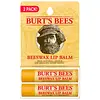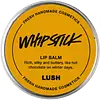Burt's Bees Beeswax Lip Balm Versus LUSH Lip Balm
What's inside
What's inside
 Key Ingredients
Key Ingredients

 Benefits
Benefits

 Concerns
Concerns

 Ingredients Side-by-side
Ingredients Side-by-side

Butyrospermum Parkii Butter
Skin ConditioningPrunus Amygdalus Dulcis Oil
Skin ConditioningBeeswax
Emulsion StabilisingHoney
HumectantOlea Europaea Fruit Oil
MaskingTheobroma Cacao Fruit Powder
Skin ConditioningGlycerin
HumectantTriticum Vulgare Germ Oil
EmollientAroma
Avena Sativa Kernel Meal
AbrasiveCitrus Reticulata Fruit
Skin ConditioningCitrus Aurantium Sinensis Fiber
Emulsion StabilisingVanilla Planifolia Fruit Extract
Skin ConditioningTheobroma Cacao Husk
AbrasiveLimonene
PerfumingLinalool
PerfumingAnise Alcohol
PerfumingCitral
PerfumingButyrospermum Parkii Butter, Prunus Amygdalus Dulcis Oil, Beeswax, Honey, Olea Europaea Fruit Oil, Theobroma Cacao Fruit Powder, Glycerin, Triticum Vulgare Germ Oil, Aroma, Avena Sativa Kernel Meal, Citrus Reticulata Fruit, Citrus Aurantium Sinensis Fiber, Vanilla Planifolia Fruit Extract, Theobroma Cacao Husk, Limonene, Linalool, Anise Alcohol, Citral
 Reviews
Reviews

Alternatives
Ingredients Explained
These ingredients are found in both products.
Ingredients higher up in an ingredient list are typically present in a larger amount.
Limonene is a fragrance that adds scent and taste to a formulation.
It's found in the peel oil of citrus fruits and other plants such as lavender and eucalyptus. The scent of limonene is generally described as "sweet citrus".
Limonene acts as an antioxidant, meaning it helps neutralize free radicals.
When exposed to air, oxidized limonene may sensitize the skin. Because of this, limonene is often avoided by people with sensitive skin.
The term 'fragrance' is not regulated in many countries. In many cases, it is up to the brand to define this term. For instance, many brands choose to label themselves as "fragrance-free" because they are not using synthetic fragrances. However, their products may still contain ingredients such as essential oils that are considered a fragrance.
Learn more about Limonene